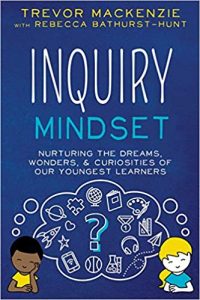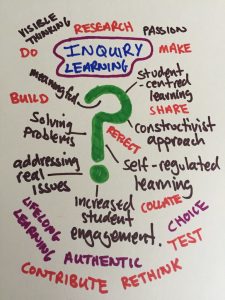Back when I taught grade 4/5 in 2014, I collaborated with my colleagues to create an amazing inquiry experience we called, Two Worlds Meet. This project was centred around and assessed within the Social Studies curriculum with the initial goal of incorporating more local, authentic First Nations content. Most of the students really enjoyed it, but I believe we teachers enjoyed it even more. It consumed far more time than our administrators generously gave us, but we enjoyed the collaboration time and together; we designed a project that is still in use today. Since then, I moved away from intermediate students and into the world of Kindergarten.
When I dropped back into Kindergarten, an interesting thing happened. I stopped thinking about inquiry and focused more on play-based and outdoor learning experiences. Play-based learning really has a lot of the elements of Inquiry in it. I spend a lot of time noticing what the students are choosing to play and then, asking them if they want to explore more about it. For example, I noticed two children really enjoyed drawing monkeys so I sat with them as they drew and asked them what they knew about monkeys. Then, during my lunch hour, I found some videos and books about monkeys that they could check out during choice time.
When Trevor Mackenzie came into our EdTech MEd class this week, I thought to myself, “Oh yeah, inquiry. Where does that fit in Kindergarten?” I reflected back on those monkey boys, and thought that if I had been thinking with my inquiry-based brain, I might have taken it further. Why didn’t I ask them about their wonderings? Why didn’t I have them share their learning with the class ? Why didn’t I get the iPads out and have them share their learning through a simple app? My answer is, because I am the lone adult in such a busy room. Where can I get that kind of time? How do I focus on teaching a small group an app when there are so many other activities and behaviours to monitor during choice time? Then I look at the book, Inquiry Mindset, and find the profile of Mackenzie’s co-author, Rebecca Bathurst-Hunt, at the back. She is a Kindergarten Teacher! Now I need to read the book and Rebecca’s blog, and follow her on Twitter.
? Why didn’t I get the iPads out and have them share their learning through a simple app? My answer is, because I am the lone adult in such a busy room. Where can I get that kind of time? How do I focus on teaching a small group an app when there are so many other activities and behaviours to monitor during choice time? Then I look at the book, Inquiry Mindset, and find the profile of Mackenzie’s co-author, Rebecca Bathurst-Hunt, at the back. She is a Kindergarten Teacher! Now I need to read the book and Rebecca’s blog, and follow her on Twitter.
Next, we met Jeff Hopkins from Pacific School of Innovation and Inquiry (PSII). The school’s website claims, “Through a formal inquiry process, learners at PSII (we pronounce it “sigh”) develop interdisciplinary pathways leading to learning activities that take them through a curriculum all their own, while also meeting or exceeding BC graduation requirements.” Listening to Jeff, I was excited for the possibilities for those learners and then, I started thinking about what could I use in Kindergarten. What if I could talk my two Kindergarten teacher colleagues at my school into adapting the PSII model for our learners? I thought about PSII’s layout. What if we had one of our classroom’s as “the noisy room”, one as the room with the “working hum”, and one with “quiet space”? What if our learners could move from one space to the other, with one teacher in each room? I do not think our learners can schedule their own time like PSII learners can, but what if we could schedule the children taking into account their needs and interests. Could we schedule small levelled groups for short, focussed lessons on the basics? Could we schedule large group times for gym, music, and French? Could we schedule small inquiry group sessions that incorporate literacy, numeracy, social studies, science, art, and technology? Would a model such as this meet the social-emotional needs of our students? Would the children be able to establish good social connections? Can my colleagues and I agree on how to implement, assess, and report on progress? How would parents and administrators respond? It is an exciting idea, but it would require an enormous investment of time and energy to get off the ground. But still, it’s there: Kindergarten meets PSII.

Leave a Reply